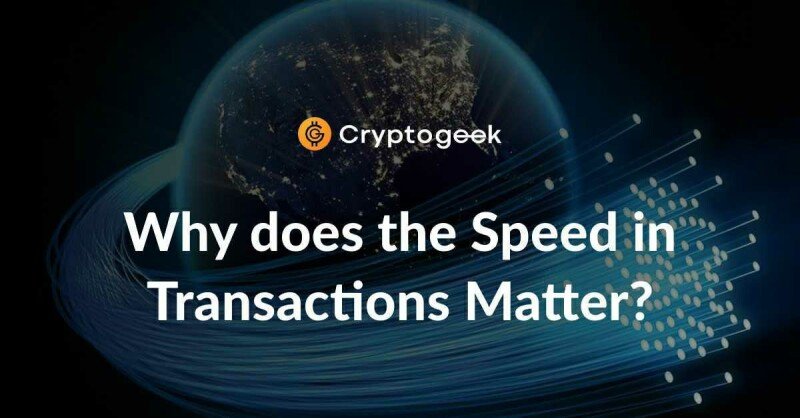Why Does The Speed In Blockchain Transactions Matter?


Have you ever asked yourself why blockchain is still not a regular part of our lives? Big companies are investing money in blockchain research, they implement blockchain solutions, smart and successful people talk about DLT (distributed ledger technologies) as something revolutionary, we hear that the future is decentralized, etc. At the very same time, we are not far from the point we were years ago — most of the latest Internet trends seem little to do with blockchain, this most important novelty. So why?
Many people tend to associate blockchain solely with cryptocurrencies. They may say that cryptocurrencies are too volatile to be a convenient means of payment. This statement ignores the fact that cryptocurrencies are already used as means of payment although fiat money is still a preferred tool. In this article, we are going to focus on the other serious drawback of blockchain technology — poor scalability. For years leading minds of the industry are working to find the solution to make the blockchain-based networks capable of processing thousands or even millions of transactions per second. Blockchain won't be a usual everyday technology in any part of the world until the scalability problem is solved.
In this article, we will explain why the meaning of high transaction speed is extremely significant and list several solutions aimed to increase speed. We will talk about Segregated Witness, Lightning Network, and innovative consensus protocols that increase scalability, also we will mention solutions developed for individual cryptocurrency platforms (using the example of Freewallet), and learn what is transactions batching and how it can help to make transactions faster and cheaper. However, the very first topic is transaction speed, its importance, and challenges in making this speed higher.
Transaction Speed
The high scalability of a certain blockchain implies that the network has high transaction speed. It allows different accounts to exchange data between each other quickly or even immediately regardless of the network load. It requires the fast confirmation of transactions in the network.
Transaction speed depends on the following four parameters: such fixed figures as the block time and block size and two unconstant parameters: the network load, and transaction fees.
- Block size is a constant set by the blockchain creators. This size determines how much data can be contained in one block. For example, the Bitcoin block size can't surpass 1 MB although with the implementation of SegWit and Lightning Network this parameter can reach 2-4 MB.
- Block time (that at times is confused with transaction speed) is another constant meaning the fixed period of time required to create a new block. On the Bitcoin blockchain, a new block gets found every 10 minutes while Litecoin developers decreased this figure to 2.5 minutes.
- The network load (or traffic) stands for the number of active nodes exchanging transactions at the given moment of time. The higher the number of active users is, the bigger is load. Understandingly it affects the transaction speed in a negative way.
- A transaction fee on most of the blockchain platforms determines the priority of the transaction. The higher the fee is, the higher is the priority.
All these factors combined influence the speed of each transaction. Transactions take from a few minutes up to months to get complete. Such uncertainty and volatility in the transaction speed make blockchain services not effective for use of the broader audience. At peaks of the network load, the platforms get slow and thousands of people get affected (once an Ethereum blockchain which is vital for thousands of companies has lost 20% of its speed because of the viral popularity of the CryptoKitties game built on top of the Ethereum platform). Such a situation is not appropriate for people living in 2020 when the Internet speed is high enough to forget about such problems while using centralized platforms.
That's why everyone (in the blockchain information field) is talking about bandwidth (the number of transactions per second). Blockchain platforms have a lot of work to do as Visa is capable of processing up to 24,000 of transactions per second, PayPal does only 193 TPS while Bitcoin processes around 7 transactions per second.
Of course, we can't judge the transaction speed of all blockchain-based platforms looking at the achievements of the Bitcoin network as it is one of the slowest in the industry. Ethereum is capable of processing 20 transactions per second, Ripple is much faster than PayPal with roughly 1.5 thousand transactions per second but still... There's a lot of work to do to bring these platforms to a new level and make them more attractive than banks for the general public. More than that, many developers from the blockchain industry say that their platforms have the potential to demonstrate such scalability that will allow processing thousands, millions, or even an infinite number of transactions per second. Let's take a glance at the solutions discussed in the field and not forget to mention the examples of the platforms that already process transactions quickly or stably.
Solutions & Examples
On the surface, the solution seems to be obvious. The speed becomes higher when the block size gets bigger and the block time gets shorter. But as usual, the devil is in the details. If the block time is short, there is a chance that the block will not find its parent block, won't get into the mainchain and as a result, will become an orphan block. Such blocks are invalid and transactions in such blocks get discarded despite being confirmed. Bitcoin has a large block time (10 minutes) but on the other hand, the Bitcoin network has not had a single orphan block in the over ten years.
Small block size is important to keep the networks from DDoS attacks. Spamming with 1 MB blocks is not as dangerous as spamming with 100 MB blocks. That's why the increase in block size is always a risk. Note that all this time Bitcoin was a safe platform with its initial block size and block time. Also, it was slow and it is still slow.
Happily, the solution for speeding the Bitcoin network up was found. Via the implementation of the so-called Lightning Network, the developers hope to solve the scalability problem of the very first cryptocurrency. Transactions are supposed to be instant and cheap (or even free). Lightning Network became possible after the activation of the Segregated Witness protocol (SegWit) which allows increasing block size without invasive changes in the network structure. SegWit was activated back in 2017 but still, Lightning Network is under development and has lots of problems. Moreover, some researchers warn that the implementation of Lightning Network will lead to dangerous centralization of the Bitcoin network.
Another solution is batching small transactions into one transaction. It will decrease the size of participating transactions so each block will contain more payments. Only a small percent of the transaction weight is related to the amount of a sent money. So combining several amounts into one reduces fees and saves much space for other transactions in the same block. Although the solution is quite elegant it is obvious that it's not a game-changer. However, batching transactions became a normal thing for cryptocurrency exchanges that depend on the high capacity to let the traders do transactions on time. The most serious problem with this solution is that one cannot batch transactions coming from different wallets. The method works only if one person/institution is sending money to several recipients at once. Additionally, just like Lightning Network, this method is only good for Bitcoin and Bitcoin-based currencies.
Besides popular consensus protocols such as Proof-of-Work or Proof-of-Stake, there are platforms with more exotic mechanisms allowing a bigger number of transactions per second, such as Freewallet.
It would be a misconception to think that only the developers of blockchains and ecosystems are moving the speed of transactions forward. At times, the smaller platforms dealing with the exchange of coins are coming up with their solutions, too. For example, in a joint effort, Freewallet and Changelly have provided their users with a feature of fast exchange transactions. Reportedly, they get executed in 3 minutes at worst. Additionally, the companies declare that this service maintains higher privacy of transactions. We are not going to dive into the details of the service architecture here and only note that the possible drawbacks of this feature are that it's limited to a number of 54 supported coins (several ERC20 tokens, BTC, USDT, LTC, DOGE, and so on) and the dependence on centralized platforms.
Conclusion
As for now, unfortunately, most of the existing scalability solutions are plagued with a decrease in decentralization hence safety. We need the solutions that won't compromise decentralization as it is one of the prime blockchain characteristics that give it a revolutionary potential.
As soon as the scalability issue is solved, humanity will have an opportunity to change the way of global and local interaction in many spheres as blockchains will make many complicated things more transparent and simple and eliminate the need to depend on trust because frauds will be impossible or too costly. That's why we should keep our eyes and ears on this scalability discussion as it is one of the final barriers that separate us from the future. For anyone wishing to stay tuned in relation to the actual technologies, Lightning Network, SegWit, transactions batching, sharding, and many other solutions of the scalability issue (including those not mentioned in this article) is a meaningful knowledge.









Here are no comments yet. Be the first!